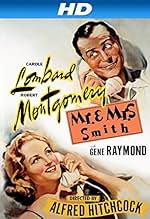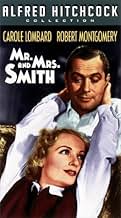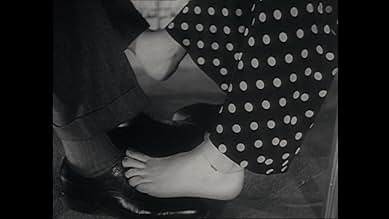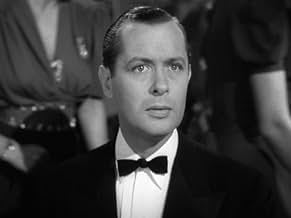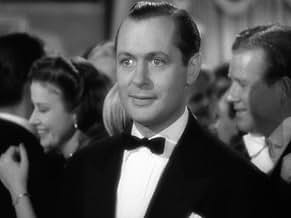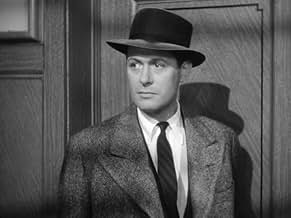IMDb-BEWERTUNG
6,3/10
11.697
IHRE BEWERTUNG
Ein Paar, das seit drei Jahren verheiratet ist, ist schockiert, wenn es erfährt, dass seine Ehe nicht rechtsgültig ist.Ein Paar, das seit drei Jahren verheiratet ist, ist schockiert, wenn es erfährt, dass seine Ehe nicht rechtsgültig ist.Ein Paar, das seit drei Jahren verheiratet ist, ist schockiert, wenn es erfährt, dass seine Ehe nicht rechtsgültig ist.
Pamela Blake
- Lily
- (as Adele Pearce)
Ernie Adams
- Bellhop
- (Nicht genannt)
Ernie Alexander
- Bellhop at Lodge
- (Nicht genannt)
Murray Alper
- Harold - Taxi Driver
- (Nicht genannt)
Tex Brodus
- Nightclub Patron
- (Nicht genannt)
Handlung
WUSSTEST DU SCHON:
- WissenswertesCarole Lombard directed Sir Alfred Hitchcock's cameo and made him do repeated takes.
- PatzerBecause the Smiths entered into the marriage in good faith and were unaware at the time that the marriage was invalid, their marriage is, in fact, still legal under American law.
- VerbindungenFeatured in Verbrechen und andere Kleinigkeiten (1989)
- SoundtracksThe Sidewalks of New York
(1894) (uncredited)
Music by Charles Lawlor
In the score during scenes at Mamma Lucy's
Ausgewählte Rezension
Because it is somewhat unique in Hitchcock's works, there has been a continuous attempt in recent years to upgrade public opinion about MR. AND MRS. SMITH. Hitchcock explained to Francois Truffault in HITCHCOCK/TRUFFAULT that he always wanted to work with Carole Lombard, and she prevailed on him to do this film with her. But that does not really explain the choice of material.
Lombard, of course, is best recalled for her wonderful daffiness in screwball comedies like NOTHING SACRED, TRUE CONFESSIONS, and MY MAN GODFREY. Her co-star, Robert Montgomery, had been in many delightful comedies (PETTICOAT FEVER, PICADILLY JIM) too. But both performers had been in dramatic films. In this period Montgomery (fresh from his great performance as Danny in NIGHT MUST FALL) had made RAGE IN HEAVEN with Ingrid Bergman and George Sanders, and Lombard did VIGIL IN THE NIGHT with Brian Ahearn. They were both highly capable of dramatic performances.
So why couldn't they have sought a more typical Hitchcock screenplay? My suspicion is that Hitchcock chose to make a "screwball comedy" as an experiment. He did that frequently when he felt like stretching his abilities, and sometimes the results were not too good. When it was a technical experiment like ROPE or DIAL "M" FOR MURDER he still had the strength of the film script to fall back on if his nine minute shots or his use of three dimensional film did not quite work wonders with the audience. But when he tried humor, he had less success.
Hitch's sense of humor is not bad - but it works best when he uses it sparingly. In THE MAN WHO KNEW TOO MUCH (1956), Hitch sets up a delayed joke involving Hillary Brooke and another actor coming to visit their friends Jimmy Stewart and Doris Day in London. Stewart and Day leave their flat because they are going to try to rescue their son (in the hands of the kidnappers). They apologize and tell Brooke and her husband they'll be back presently with their son. Brooke and her husband look confused as they leave. The remainder of the film, and the melodrama in the embassy is played out. Final scene shows Brooke and her husband have fallen asleep waiting for them. Day, Stewart and their son come in, wake up Brooke and her husband, and proceed to act as though nothing has happened for three or four hours.
That is an example of when the Hitchcock humor works. But then comes his full scale "black comedy" THE TROUBLE WITH HARRY, and the viewer has mixed feelings. Individual moments work, like the manipulation of the dull sheriff Royal Dano. But one finds most of the humor about moving a dead body fairly unimaginative...surprisingly so from Hitch.
MR. AND MRS. SMITH is not a black comedy, but it's type of bedroom farce situation would have been better handled by Ernst Lubitsch or Leo McCarey or Preston Sturgis. The joke is that the surface-warring Smiths are really in love, but discover that their marriage was illegal. Montgomery had said he'd marry Lombard again if he had to (prior to the discovery of the illegal marriage), but instead of rushing Lombard off to any nearby church or justice of the peace he hesitates. And Lombard wonders what kind of man she has been illegally married to. So she turns to his partner Gene Raymond, who is interested in her.
There are some interesting moments in the film (Hitchcock has to be of interest always). The scene where Montgomery pretends to be talking to the pretty woman sitting next to him (incurring the ire of her date) is good, culminating in Jack Carson trying to stop a bleeding nose on Montgomery by using a "cold" knife as a cauterizing instrument. There is also a funny moment when Lombard and Raymond, on a trip to an amusement park, get stuck on a ferris wheel on top of it during a heavy thunder storm. But these moments are far and few. As a romantic comedy it is mediocre, despite it's stars and (unfortunately) because of it's director. Hitchcock must have realized it too - until THE TROUBLE WITH HARRY he never attempted a straight comedy again, and (as mentioned before) THE TROUBLE WITH HARRY was not a romantic comedy but a "black comedy".
Lombard, of course, is best recalled for her wonderful daffiness in screwball comedies like NOTHING SACRED, TRUE CONFESSIONS, and MY MAN GODFREY. Her co-star, Robert Montgomery, had been in many delightful comedies (PETTICOAT FEVER, PICADILLY JIM) too. But both performers had been in dramatic films. In this period Montgomery (fresh from his great performance as Danny in NIGHT MUST FALL) had made RAGE IN HEAVEN with Ingrid Bergman and George Sanders, and Lombard did VIGIL IN THE NIGHT with Brian Ahearn. They were both highly capable of dramatic performances.
So why couldn't they have sought a more typical Hitchcock screenplay? My suspicion is that Hitchcock chose to make a "screwball comedy" as an experiment. He did that frequently when he felt like stretching his abilities, and sometimes the results were not too good. When it was a technical experiment like ROPE or DIAL "M" FOR MURDER he still had the strength of the film script to fall back on if his nine minute shots or his use of three dimensional film did not quite work wonders with the audience. But when he tried humor, he had less success.
Hitch's sense of humor is not bad - but it works best when he uses it sparingly. In THE MAN WHO KNEW TOO MUCH (1956), Hitch sets up a delayed joke involving Hillary Brooke and another actor coming to visit their friends Jimmy Stewart and Doris Day in London. Stewart and Day leave their flat because they are going to try to rescue their son (in the hands of the kidnappers). They apologize and tell Brooke and her husband they'll be back presently with their son. Brooke and her husband look confused as they leave. The remainder of the film, and the melodrama in the embassy is played out. Final scene shows Brooke and her husband have fallen asleep waiting for them. Day, Stewart and their son come in, wake up Brooke and her husband, and proceed to act as though nothing has happened for three or four hours.
That is an example of when the Hitchcock humor works. But then comes his full scale "black comedy" THE TROUBLE WITH HARRY, and the viewer has mixed feelings. Individual moments work, like the manipulation of the dull sheriff Royal Dano. But one finds most of the humor about moving a dead body fairly unimaginative...surprisingly so from Hitch.
MR. AND MRS. SMITH is not a black comedy, but it's type of bedroom farce situation would have been better handled by Ernst Lubitsch or Leo McCarey or Preston Sturgis. The joke is that the surface-warring Smiths are really in love, but discover that their marriage was illegal. Montgomery had said he'd marry Lombard again if he had to (prior to the discovery of the illegal marriage), but instead of rushing Lombard off to any nearby church or justice of the peace he hesitates. And Lombard wonders what kind of man she has been illegally married to. So she turns to his partner Gene Raymond, who is interested in her.
There are some interesting moments in the film (Hitchcock has to be of interest always). The scene where Montgomery pretends to be talking to the pretty woman sitting next to him (incurring the ire of her date) is good, culminating in Jack Carson trying to stop a bleeding nose on Montgomery by using a "cold" knife as a cauterizing instrument. There is also a funny moment when Lombard and Raymond, on a trip to an amusement park, get stuck on a ferris wheel on top of it during a heavy thunder storm. But these moments are far and few. As a romantic comedy it is mediocre, despite it's stars and (unfortunately) because of it's director. Hitchcock must have realized it too - until THE TROUBLE WITH HARRY he never attempted a straight comedy again, and (as mentioned before) THE TROUBLE WITH HARRY was not a romantic comedy but a "black comedy".
- theowinthrop
- 12. Juni 2006
- Permalink
Top-Auswahl
Melde dich zum Bewerten an und greife auf die Watchlist für personalisierte Empfehlungen zu.
Details
- Laufzeit1 Stunde 35 Minuten
- Farbe
- Seitenverhältnis
- 1.37 : 1
Zu dieser Seite beitragen
Bearbeitung vorschlagen oder fehlenden Inhalt hinzufügen




